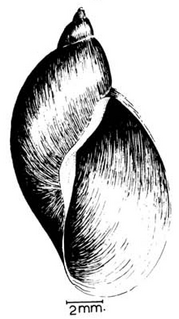Related Research Articles

Digenea is a class of trematodes in the Platyhelminthes phylum, consisting of parasitic flatworms with a syncytial tegument and, usually, two suckers, one ventral and one oral. Adults commonly live within the digestive tract, but occur throughout the organ systems of all classes of vertebrates. Once thought to be related to the Monogenea, it is now recognised that they are closest to the Aspidogastrea and that the Monogenea are more closely allied with the Cestoda. Around 6,000 species have been described to date.

Plagiorchiida is a large order of trematodes, synonymous to Echinostomida. They belong to the Digenea, a large subclass of flukes. This order contains relatively few significant parasites of humans.

Biomphalaria glabrata is a species of air-breathing freshwater snail, an aquatic pulmonate gastropod mollusk in the family Planorbidae, the ram's horn snails.

Radix natalensis is a species of freshwater snail, an aquatic gastropod mollusc in the family Lymnaeidae.
Plagiorchis is a genus of parasitic trematodes (flukes) in the family Plagiorchiidae.
Plagiorchis elegans is a species of parasitic trematodes (flukes) in the genus Plagiorchis. Its host is Stagnicola elodes.
Choledocystus is a genus of parasitic flukes, flatworms in the family Plagiorchiidae.

Plagiorchis vespertillionis, also sometimes listed as Plagiorchis vespertilionis, is a species of trematode that parasitizes bats. It was described as a new species in 1780 based on specimens collected from a brown long-eared bat in Denmark. In 2007, it was documented within a human host for the first time.
References
| | This Trematoda (fluke)- related article is a stub. You can help Wikipedia by expanding it. |